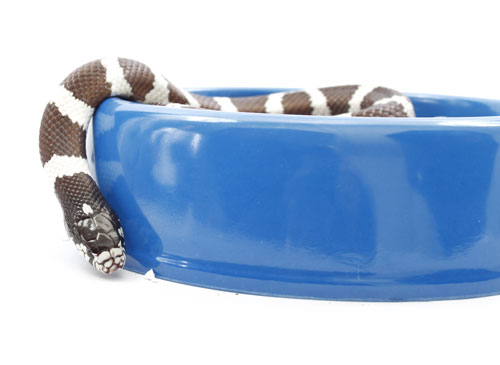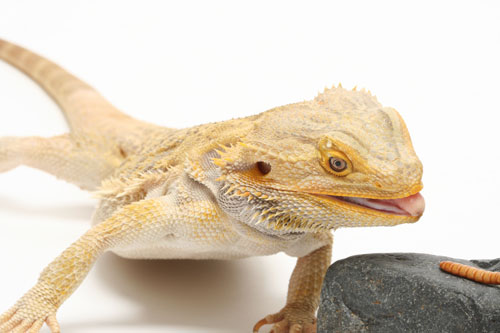Proper reptile nutrition requires six essential components.
Providing optimal nutrition and meeting husbandry requirements are important to reptile health. Besides focusing on keeping animals, herpkeepers often hope to reproduce them. Breeding efficiency has become the measure of success, and because of this, reptiles are kept at optimal breeding conditions for extended periods of time. Ultimately the unnatural stress of continuous breeding taxes their growth and reproductive systems. This stress depletes nutrient reserves, particularly calcium, and leads to “calcium crashing,” when an animal’s body pulls calcium from its bones to shell its eggs. This often means death or disfigurement for the adult. The following are the essential components of reptile nutrition and husbandry that contribute to effective digestion and nutrient utilization.
1. Hydrate Your Reptiles For Health
Reptiles require water. Without proper hydration, digestion can be halted, preventing nutrient absorption. In their natural habitat reptiles conserve water efficiently. Some live in arid lands and go for long periods of time without drinking. However, reptiles escape the heat by retreating into deep burrows in the ground, which can be moist and cool. This humid microclimate helps to keep them hydrated. They also obtain water through what they eat, such as insects or plant material. Early morning dew also provides some animals with water. As you can see, besides the obvious rain and access to running water, a wild reptile can satisfy its moisture requirements in many other ways.

Photo by Gina Cioli/I-5 Studio
Reptiles require water. Without proper hydration, digestion can be halted, preventing nutrient absorption.
Captive reptiles, however, are not able to resort to most of these methods, so the keeper must provide moisture. Often this is via misting, periodic soaking, a water bowl or a combination of these methods. Research your animal’s water needs, and make sure you fulfill them.
2.Watch the Temperature
Reptiles are ectothermic animals and require heat to digest their meals. If this temperature requirement isn’t met, food can rot in the gut and cause detrimental damage to the reptile. It is crucial to provide high enough temperatures so the reptile can metabolize and digest its food and absorb nutrients.
But these higher temps shouldn’t permeate the animal’s entire enclosure. Consider a dry terrarium with glass sides, a screen top and a basking light. One person may call it the perfect reptile habitat, but someone else may call it a great appliance for making beef jerky. If a herpkeeper isn’t careful, even a desert-adapted reptile can quickly overheat, become dehydrated and die in such an enclosure. Research your animal’s temperature needs so you can provide the proper gradient. Reptiles will take it from there.
3. Mind Your Minerals
Because reptiles are viewed as specialty pets, little research has been done on their nutritional requirements, and much of what does exist isn’t publicly available. Manufacturer recommendations for the use of nutritional products also vary, as does the inclusion ratio between vitamin D3 and calcium.
Let’s look at the research done on chickens. Potential profit drives animal research, and there is a huge financial incentive to grow a chicken faster, and make sure it’s healthy and fertile. Avian research, specifically on poultry, has been a good starting point. Combine it with the reptile research that has been done, and we are on our way toward reaching reptiles’ nutritional requirements.
In poultry studies the levels of actual calcium (not calcium carbonate) used in complete feeds range from 1 to 1.5 percent of the product’s weight depending on the brand and type of feed, such as starter, broiler or layer. This correlates well with studies done with leopard geckos. Look at complete diet formulas from large reptile-diet manufacturers that have done research, and you find that most complete reptile diets fall within these parameters.
From my own personal trials and after comparing notes with peers, I’ve found that calcium levels at and above 2 percent can cause problems. Calcium in high doses can act as a binder, which inhibits absorption of essential nutrients, such as other vitamins and minerals. In the presence of too much vitamin D3, excess calcium can calcify internal organs. As anyone who has ever taken calcium for indigestion should know, calcium neutralizes stomach acids, which are necessary for the digestion and absorption of all nutrients. Balance is key. Giving a reptile a large dose of calcium is not the same as giving it a smaller amount with each feeding.
The importance of calcium in reptile nutrition is of high concern. Calcium deficiency is a common problem, especially with reptiles pressured into longer-than-natural breeding seasons. This situation causes unnatural stress on females to produce more eggs, so they require more calcium. Remember, however, that it is not just a lack of calcium that creates this problem, but also a complex relationship between many vitamins and minerals.
Phosphorous, and its relationship to calcium, is also important. Animalkeepers generally agree that an inclusion ratio of 2-to-1 (calcium to phosphorous) is optimal. This is a common ratio measured in the healthy bone analysis of most vertebrates. To err on the high side with calcium is generally much easier for an animal to metabolize than a diet with a ratio less than 2-1. Even a 3-1 ratio is metabolized efficiently by most organisms.
4. Provide Important Vitamin D3
Vitamin D3 is by far the most important vitamin in reptile nutrition. In nature a reptile synthesizes vitamin D3 via the skin’s absorption of ultraviolet rays from the sun. It is also found in the liver and kidneys of vertebrates. Most captive reptiles are kept indoors, and most, other than snakes, are not fed significant amounts of whole vertebrates. Without getting vitamin D3 naturally in their diet, reptiles rely on their keepers to provide a source that replaces, if balanced correctly, the need for sunlight.

Photo by Gina Cioli/I-5 Studio
Lizards such as bearded dragons benefit from having their feeders dusted with a vitamin/mineral supplement and calcium.
Getting the dosage right is not easy. Vitamin D3 is fat-soluble, and excess supplementation can create toxicity, which can prove fatal. Deficiency, on the other hand, can cause secondary hyperparathyroidism, which is not usually detected until it becomes severe enough to cause symptoms such as “floppy jaw,” or broken or kinked limbs and spines.
Quality UVB-producing bulbs can replace the need for dietary vitamin D3, but all bulbs decrease in UVB output over time and must be replaced on a regular basis. Testing the bulb frequently with a UVB-bulb meter will help you monitor its level of effectiveness.
Meeting the needs of nocturnal species may prove more difficult, especially if they’re housed in cages too small to provide significant temperature gradients or too short to accommodate bulbs. Nocturnal reptiles may be more sensitive to bright light, and in nature they get their UVB in the early morning and evening when exposure is more controlled. They may completely avoid a bright bulb in captivity and remain in their hides. For these animals, nutritional supplementation is essential.
Vitamin D3 supplementation is achieved through a calcium and vitamin D3 combination, vitamin-only powders, or in some cases an all-in-one formula. The variety of calcium and vitamin D3 ratios available in today’s reptile supplements varies from 20,000 to 400,000 international units per kilogram.
When you consider that these supplements are marketed for the same purpose, things get complicated. Supplements with a higher dose obviously have a higher possibility of producing toxicity. I could write a whole article on vitamin D3, but I’ll summarize with my opinion that optimal levels for a dusting powder should be closer to the low end of the range, between 60,000 and 120,000 international units per kilogram, depending on frequency of use and target species.
A huge factor in calcium and vitamin D3 supplementation is how often to use it. Again, different supplements have different instructions. Herpkeepers also have to supplement other vitamins, such as vitamin A, and match their levels to those of the calcium and vitamin D3 supplement. When these vitamins are in different supplements, getting the right ratio can be a nightmare. Most herpkeepers develop their own supplementation regimen after much trial and error. However, the recent addition of well-researched, all-in-one vitamin and calcium supplements has done much to reduce the margin of error.
5.Vitamin A Is OK
Vitamin A is the next most important vitamin in reptile nutrition. It is essential to good eye and skin health. There is much confusion about forms of this vitamin. It only comes in one form, pre-formed vitamin A (retinol), which is found in animal sources (such as the liver). However, pre-vitamin-A nutrients known as carotenoids come from plant matter, and beta carotene is the most well known. Many animals’ bodies can convert these nutrients into vitamin A, but true carnivores, such as cats, have lost the ability.
Carotenoids provide much more nutritional benefit than their ability to be converted into retinol. They’re an important part of a balanced diet, but I think they shouldn’t be relied on exclusively as a vitamin A source for reptiles. Whether insectivorous and carnivorous reptiles can convert carotenoids into vitamin A is questionable. More research is needed.
Vitamin A deficiency is common in reptiles, but it’s not as easily recognized as vitamin D3 deficiency. The first signs are typically shedding problems and eye problems, which can show up as obvious vision problems or, more commonly, as eye deformities in captive-bred hatchlings. It has recently been shown that vitamin A deficiency could also be the key factor in poor tadpole development, a condition known as “spindly legs.”
More than a decade ago a big scare concerning vitamin A toxicity panicked chameleonkeepers, and retinol-free supplements were developed. The scare was later proven to be invalid, but the stigma remains. There is simply no reason not to include pre-formed vitamin A in reptile supplementation. Toxicity is rare, but deficiency is common. Moderate levels of vitamin A in combination with carotenoids seem, at this point, to be the best way to assure reliable vitamin A delivery.
6. Reconsider Common Knowledge
Many people believe calcium degrades vitamins and they should not be mixed together, but today it is not necessarily the truth. Minerals can contribute to vitamin degradation, but vitamin manufacturers have addressed the concerns many have about this issue. Top-of-the-line vitamins have been engineered to be much more molecularly stable than in the past. Vitamins can now be coated or encapsulated into tiny beadlets quite stable and resistant to oxidation. The bottom line is that stability after one year will be reduced in a pure vitamin mix as well as a calcium-vitamin powder. What is important is the quality and stability of the form of the vitamin being used and the freshness of the product.
In conclusion, many key factors must be addressed to provide reptiles and amphibians with proper supplementation. Correct temperature and hydration must be combined with a proper blend of vitamins, minerals and UVB. All must be done at the right ratios and proper combination to provide reptiles with balanced supplementation they can properly metabolize.
While keeping these things straight, remember it’s also important to deliver supplemental vitamins and minerals at the same time. There is a direct relationship between vitamin and mineral usage. Supplementing minerals one day and vitamins the next is not the way to deliver them because the presence of one often helps in the absorption of the other.
The relationship between vitamins and minerals is complex, and many factors can affect how they’re metabolized. Reptile supplementation has come a long way in the past few decades, but it still has a long way to go.
ALLEN REPASHY is a pioneer in the captive propagation of reptiles and amphibians. He has focused on the Rhacodactylus genus for the past 15 years. Also focusing on reptile nutrition, he has developed a line of diets and supplements based on his research and trials. Visit his website at http://www.Repashy.com


